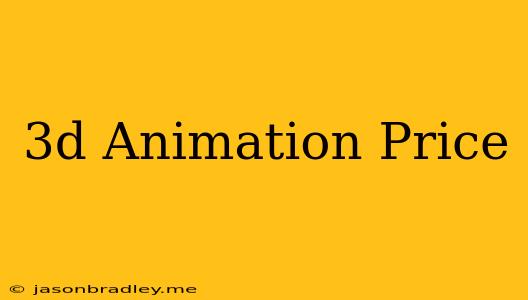3D Animation Pricing: A Comprehensive Guide
3D animation is a powerful tool for businesses and individuals to bring their ideas to life. From product demonstrations to engaging commercials, 3D animation can elevate your content and make a lasting impression. But before you dive into this exciting world, it's important to understand the costs involved.
Factors Influencing 3D Animation Pricing:
1. Project Scope and Complexity: The most significant factor influencing 3D animation pricing is the complexity and scope of your project. A simple 30-second explainer video will cost less than a full-fledged animated film.
- Length of the animation: A longer video will naturally require more time and effort.
- Number of characters and environments: More characters and environments require additional modeling, texturing, and animation, increasing the overall cost.
- Level of detail: Highly detailed characters and environments demand advanced modeling and rendering, resulting in higher pricing.
- Special effects and visual effects (VFX): Complex special effects like explosions, smoke, or water simulations add to the production cost.
2. Animation Style and Quality:
- Style: The chosen animation style, be it realistic, cartoonish, or stylized, will affect the time and effort required.
- Quality: High-resolution animation with detailed textures and lighting will be more expensive than simple, low-resolution animation.
3. Animation Studio Expertise and Experience:
- Studio Size and Reputation: Larger, more established studios with a proven track record often have higher rates due to their experience and resources.
- Expertise in Specific Software and Techniques: Studios specializing in specific 3D animation software or techniques might charge a premium for their unique expertise.
4. Project Timeline:
- Rush orders: Tight deadlines often require overtime work and can increase the overall cost.
5. Additional Services:
- Storyboarding: Developing a detailed storyboard can be an additional expense, though it's crucial for ensuring a clear vision for the animation.
- Voiceover and Music: These elements are essential for creating an engaging animated experience and can add to the budget.
- Post-production: Editing, color correction, and sound mixing are important post-production stages that can incur additional costs.
Typical 3D Animation Pricing Models:
1. Hourly Rates: This model is common for smaller projects. The studio charges an hourly rate for the time spent on modeling, texturing, animating, and rendering.
2. Fixed Price: For larger projects with a well-defined scope, studios might offer a fixed price based on the estimated time and effort required.
3. Package Deals: Some studios offer package deals that include a set of services at a pre-determined price. This can be a cost-effective option for specific types of projects.
Tips for Getting the Best Price:
- Research and Compare: Get quotes from multiple studios to ensure you're getting a competitive price.
- Be Clear About Your Needs: Clearly communicate your project scope, desired animation style, and timeline.
- Discuss Payment Terms: Understand the payment schedule and any upfront fees.
- Consider Alternative Options: If your budget is tight, consider alternative options like outsourcing to freelance animators or using online animation tools.
By understanding the factors influencing 3D animation pricing and considering the different pricing models available, you can make informed decisions and ensure that your project fits within your budget while delivering high-quality results.
